Photocatalytic oxidation of acetonitrile in aqueous suspension of titanium dioxide irradiated by sun
- 格式:pdf
- 大小:177.89 KB
- 文档页数:7
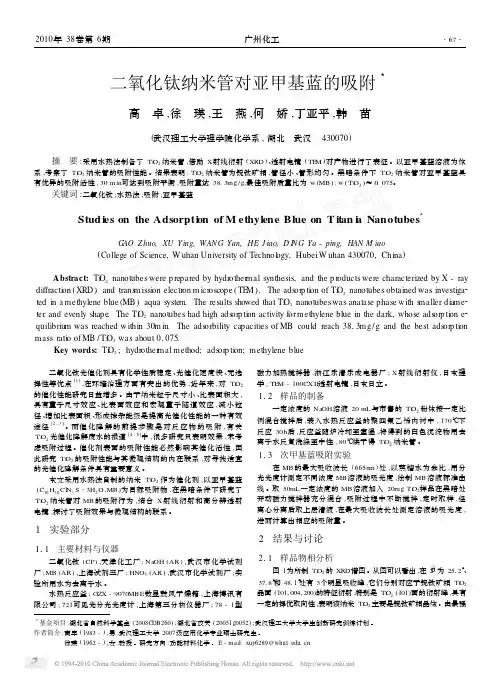
二氧化钛纳米管对亚甲基蓝的吸附3高 卓,徐 瑛,王 燕,何 娇,丁亚平,韩 苗(武汉理工大学理学院化学系,湖北 武汉 430070)摘 要:采用水热法制备了Ti O 2纳米管,借助X 射线衍射(XRD )、透射电镜(TE M )对产物进行了表征。
以亚甲基蓝溶液为体系,考察了Ti O 2纳米管的吸附性能。
结果表明:Ti O 2纳米管为锐钛矿相,管径小、管形均匀。
黑暗条件下Ti O 2纳米管对亚甲基蓝具有优异的吸附活性,30m in 可达到吸附平衡,吸附量达38.3mg/g,最佳吸附质量比为w (MB ):w (Ti O 2)≈0.075。
关键词:二氧化钛;水热法;吸附;亚甲基蓝Stud i es on the Adsorpti on of M ethylene Blue on T it an i a Nanotubes3G AO Z huo,XU Ying,WAN G Yan,HE J iao,D I N G Ya -ping,HAN M iao(College of Science,W uhan University of Technol ogy,HubeiW uhan 430070,China )Abstract:Ti O 2nanotubes were p repared by hydr other mal synthesis,and the p r oducts were characterized by X -ray diffracti on (XRD )and trans m issi on electr on m icr oscope (TE M ).The ads or p ti on of Ti O 2nanotubes obtained was investiga 2ted in a methylene blue (MB )aqua syste m.The results showed that Ti O 2nanotubeswas anatase phase with s maller dia me 2ter and evenly shape .The Ti O 2nanotubes had high ads or p ti on activity f or methylene blue in the dark,whose ads or p ti on e 2quilibriu m was reached within 30m in .The ads orbility capacities of MB could reach 3813mg/g and the best ads or p ti on mass rati o of MB /Ti O 2was about 01075.Key words:Ti O 2;hydr other mal method;ads or p ti on;methylene blue3基金项目:湖北省自然科学基金(2008CDB260);湖北省攻关(20051g0052);武汉理工大学大学生创新研究训练计划。
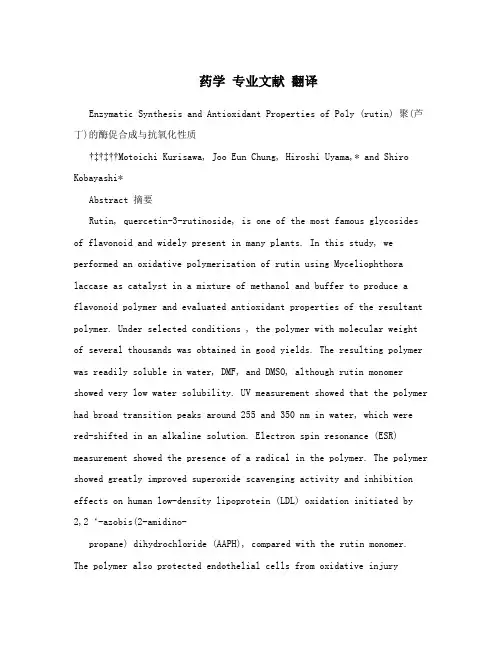
药学专业文献翻译Enzymatic Synthesis and Antioxidant Properties of Poly (rutin) 聚(芦丁)的酶促合成与抗氧化性质†‡†‡††Motoichi Kurisawa, Joo Eun Chung, Hiroshi Uyama,* and Shiro Kobayashi*Abstract 摘要Rutin, quercetin-3-rutinoside, is one of the most famous glycosides of flavonoid and widely present in many plants. In this study, we performed an oxidative polymerization of rutin using Myceliophthora laccase as catalyst in a mixture of methanol and buffer to produce a flavonoid polymer and evaluated antioxidant properties of the resultant polymer. Under selected conditions , the polymer with molecular weight of several thousands was obtained in good yields. The resulting polymer was readily soluble in water, DMF, and DMSO, although rutin monomer showed very low water solubility. UV measurement showed that the polymer had broad transition peaks around 255 and 350 nm in water, which were red-shifted in an alkaline solution. Electron spin resonance (ESR) measurement showed the presence of a radical in the polymer. The polymer showed greatly improved superoxide scavenging activity and inhibition effects on human low-density lipoprotein (LDL) oxidation initiated by 2,2‘-azobis(2-amidino-propane) dihydrochloride (AAPH), compared with the rutin monomer. The polymer also protected endothelial cells from oxidative injuryinduced by AAPH as a radical generator with a much greater effect than the rutin monomer.芦丁,槲皮素芸香糖苷,是最著名的黄酮类糖苷之一,广泛存在于很多植物中。
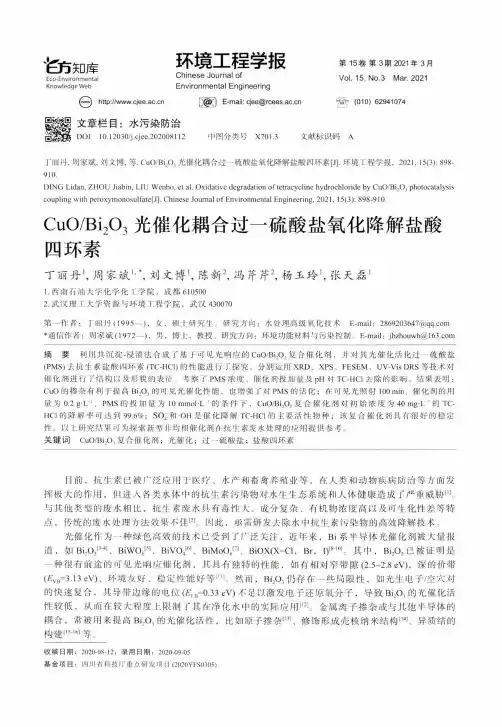
'£朽知库环境工程学报第15卷第3期2021年3月Vol. 15, No.3 Mar. 2021Eco-Environmental Knowledge Web C hinese Journal of Environmental Engineering@(010) 62941074文章栏目:水污染防治DOI 10.12030/j.cjee.202008112 中图分类号X701.3 文献标识码A丁丽丹,周家斌,刘文博,等.Cu0/Bi203光催化耦合过一硫酸盐氧化降解盐酸四环素[J].环境工程学报,2021. 15(3): 898- 910.DING Lidan, ZHOU Jiabin, LIU Wenbo, et al. Oxidative degradation of tetracycline hydrochloride by Cu0/Bi203 photocatalysis coupling with peroxymonosulfate[J]. Chinese Journal of Environmental Engineering, 2021, 15(3): 898-910.C u0/B i203光催化耦合过一硫酸盐氧化降解盐酸 四环素丁丽丹、周家斌刘文博\陈新2,冯芹芹2,杨玉玲\张天磊11. 西南石油大学化学化工学院,成都6105002. 武汉理工大学资源与环境工程学院,武汉430070第一作者:丁丽丹(1995—),女,硕士研究生。
研究方向:水处理高级氧化技术。
E-mail: ***************** *通信作者:周家斌(1972—),男,博士,教授。
研究方向:环境功能材料与污染控制:E-mail: ****************摘要利用共沉淀-浸渍法合成了基于可见光响应的Cu0/Bi203复合催化剂,并对其光催化活化过一硫酸盐 (PM S)去抗生素盐酸四环素(TC-HC1)的性能进行了探究。
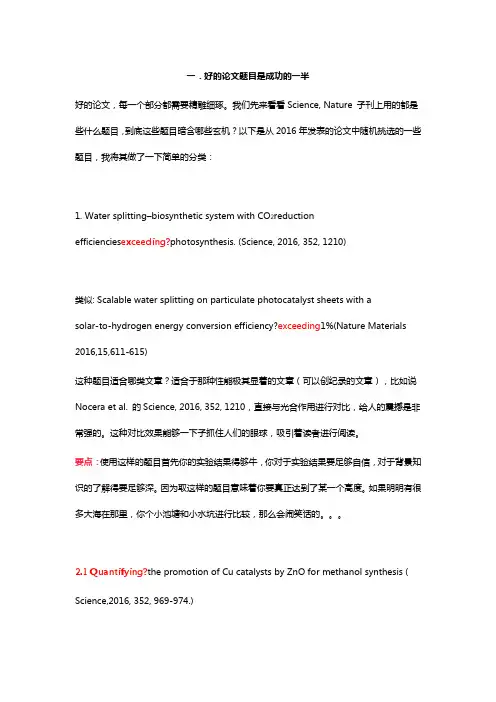
一.好的论文题目是成功的一半好的论文,每一个部分都需要精雕细琢。
我们先来看看Science, Nature 子刊上用的都是些什么题目,到底这些题目暗含哪些玄机?以下是从2016年发表的论文中随机挑选的一些题目,我将其做了一下简单的分类:1. Water splitting–biosynthetic system with CO2reductionefficiencies exceeding?photosynthesis. (Science, 2016, 352, 1210)类似: Scalable water splitting on particulate photocatalyst sheets with asolar-to-hydrogen energy conversion efficiency?exceeding1%(Nature Materials 2016,15,611-615)这种题目适合哪类文章?适合于那种性能极其显着的文章(可以创纪录的文章),比如说Nocera et al. 的Science, 2016, 352, 1210,直接与光合作用进行对比,给人的震撼是非常强的。
这种对比效果能够一下子抓住人们的眼球,吸引着读者进行阅读。
要点:使用这样的题目首先你的实验结果得够牛,你对于实验结果要足够自信,对于背景知识的了解得要足够深。
因为取这样的题目意味着你要真正达到了某一个高度。
如果明明有很多大海在那里,你个小池塘和小水坑进行比较,那么会闹笑话的。
2.1 Quantifying?the promotion of Cu catalysts by ZnO for methanol synthesis ( Science,2016, 352, 969-974.)2.2Exploring the origin of high optical absorption in conjugated polymers. (Nature Materials 2016,DOI:10.1038/nmat4645)2.3 Promoting?solution phase discharge in Li–O2 batteries containing weakly solvatingelectrolytesolutions (Nature Materials 2016, DOI: 10.1038/nmat4629)2.4 Reconstructing?solute-induced phase transformations within individual nanocrystals (NatureMaterials 2016,doi:10.1038/nmat4620)2.5 Tailoring the nature and strength of electron–phonon interactions in the SrTiO3(001) 2D electronliquid (Nature Material, 2016, doi:10.1038/nmat4623)我简单地检索了下Nature Materials上面的文章题目,发现这种类型的题目真的非常多。
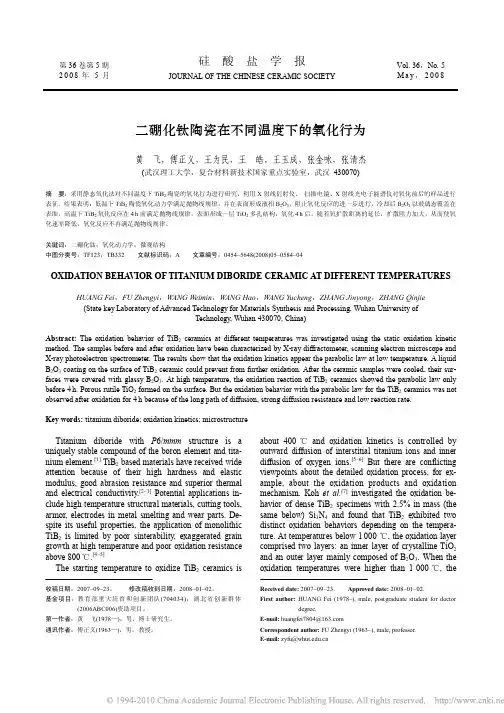
二硼化钛陶瓷在不同温度下的氧化行为黄飞,傅正义,王为民,王皓,王玉成,张金咏,张清杰(武汉理工大学,复合材料新技术国家重点实验室,武汉 430070)摘要:采用静态氧化法对不同温度下TiB2陶瓷的氧化行为进行研究,利用X射线衍射仪、扫描电镜、X射线光电子能谱仪对氧化前后的样品进行表征。
结果表明:低温下TiB2陶瓷氧化动力学满足抛物线规律,并在表面形成液相B2O3,阻止氧化反应的进一步进行,冷却后B2O3以玻璃态覆盖在表面。
高温下TiB2氧化反应在4h前满足抛物线规律,表面形成一层TiO2多孔结构;氧化4h后,随着氧扩散距离的延长,扩散阻力加大,从而使氧化速率降低,氧化反应不再满足抛物线规律。
关键词:二硼化钛;氧化动力学;微观结构中图分类号:TF123;TB332 文献标识码:A 文章编号:0454–5648(2008)05–0584–04OXIDATION BEHA VIOR OF TITANIUM DIBORIDE CERAMIC AT DIFFERENT TEMPERATURES HUANG Fei,FU Zhengyi,W ANG W eimin,W ANG Hao,W ANG Yucheng,ZHANG Jinyong,ZHANG Qinjie(State key Laboratory of Advanced Technology for Materials Synthesis and Processing, Wuhan University ofTechnology, Wuhan 430070, China)Abstract: The oxidation behavior of TiB2 ceramics at different temperatures was investigated using the static oxidation kinetic method. The samples before and after oxidation have been characterized by X-ray diffractometer, scanning electron microscope and X-ray photoelectron spectrometer. The results show that the oxidation kinetics appear the parabolic law at low temperature. A liquid B2O3 coating on the surface of TiB2 ceramic could prevent from further oxidation. After the ceramic samples were cooled, their sur-faces were covered with glassy B2O3. At high temperature, the oxidation reaction of TiB2 ceramics showed the parabolic law only before 4h. Porous rutile TiO2 formed on the surface. But the oxidation behavior with the parabolic law for the TiB2 ceramics was not observed after oxidation for 4h because of the long path of diffusion, strong diffusion resistance and low reaction rate.Key words: titanium diboride; oxidation kinetics; microstructureTitanium diboride with P6/mmm structure is a uniquely stable compound of the boron element and tita-nium element.[1] TiB2 based materials have received wide attention because of their high hardness and elastic modulus, good abrasion resistance and superior thermal and electrical conductivity.[2–3] Potential applications in-clude high temperature structural materials, cutting tools, armor, electrodes in metal smelting and wear parts. De-spite its useful properties, the application of monolithic TiB2 is limited by poor sinterability, exaggerated grain growth at high temperature and poor oxidation resistance above 800.℃[4–5]The starting temperature to oxidize TiB2 ceramics is about 400℃ and oxidation kinetics is controlled by outward diffusion of interstitial titanium ions and inner diffusion of oxygen ions.[5–6] But there are conflicting viewpoints about the detailed oxidation process, for ex-ample, about the oxidation products and oxidation mechanism. Koh et al.[7] investigated the oxidation be-havior of dense TiB2 specimens with 2.5% in mass (the same below) Si3N4 and found that TiB2 exhibited two distinct oxidation behaviors depending on the tempera-ture. At temperatures below 1000℃, the oxidation layer comprised two layers: an inner layer of crystalline TiO2 and an outer layer mainly composed of B2O3. When the oxidation temperatures were higher than 1000℃, the收稿日期:2007–09–23。
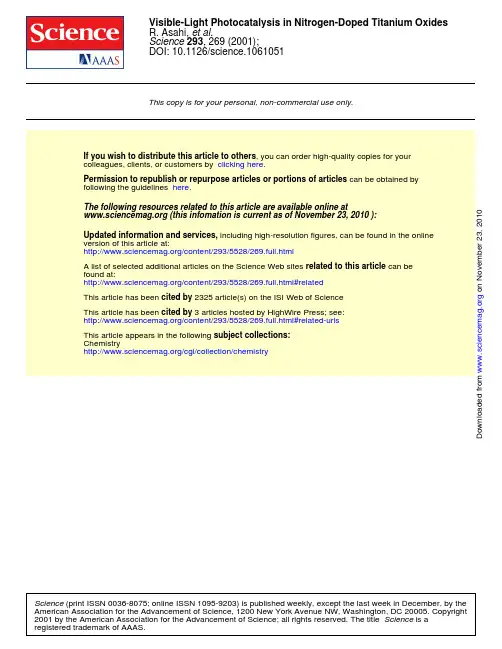
DOI: 10.1126/science.1061051, 269 (2001);293 Science , et al.R. Asahi Visible-Light Photocatalysis in Nitrogen-Doped Titanium OxidesThis copy is for your personal, non-commercial use only.clicking here.colleagues, clients, or customers by , you can order high-quality copies for your If you wish to distribute this article to othershere.following the guidelines can be obtained by Permission to republish or repurpose articles or portions of articles): November 23, 2010 (this infomation is current as of The following resources related to this article are available online at/content/293/5528/269.full.html version of this article at:including high-resolution figures, can be found in the online Updated information and services, /content/293/5528/269.full.html#related found at:can be related to this article A list of selected additional articles on the Science Web sites 2325 article(s) on the ISI Web of Science cited by This article has been /content/293/5528/269.full.html#related-urls 3 articles hosted by HighWire Press; see:cited by This article has been/cgi/collection/chemistry Chemistrysubject collections:This article appears in the following registered trademark of AAAS.is a Science 2001 by the American Association for the Advancement of Science; all rights reserved. The title Copyright American Association for the Advancement of Science, 1200 New York Avenue NW, Washington, DC 20005. (print ISSN 0036-8075; online ISSN 1095-9203) is published weekly, except the last week in December, by the Science o n N o v e m b e r 23, 2010w w w .s c i e n c e m a g .o r g D o w n l o a d e d f r o m␣S,were obtained from nsbury [J.C.Rochet et al.,Biochemistry 39,10619(2000)].21.The silver-stained band at 22kD in an HP2A immu-noprecipitate of normal human brain and a co-mi-grating silver-negative slice from an adjacent lane of a parkin-preabsorbed HP2A precipitate were excised,trypsin digested and subjected to blind analysis by mass spectrometry at MDS Proteomics,Inc.(Toronto,ON)[A.Shevchenko et al.,Anal.Chem .68,850(1996)].The HP2A-specific 22-kD protein yielded tryptic peptides corresponding to aa 13–21,44–58,46–58,59–80,61–80,81–96,and 81–97of human ␣S (GenBank accession #L08850),each ending with a lysine,as expected.No ␣S sequence was detected in the co-migrating slice from the preabsorbed lane.22.Y.Mizuno,N.Hattori,H.Mori,Biomed.Pharmaco-ther.53,109(1999).23.H.Shimura et al.,Ann.Neurol.45,668(1999).24.N.Hattori et al.,Ann.Neurol.44,935(1998).25.A.L.Talis,J.M.Huibregtse,P.M.Howley,J.Biol.Chem.273,6439(1998).26.M.Scheffner,J.M.Huibregtse,R.D.Vierstra,P.M.Howley,Cell 75,495(1993).27.Y.Jiang,E.Lev-Lehman,J.Bressler,T.F.Tsai,A.L.Beaudet,Am.J.Hum.Genet.65,1(1999).28.Human UbcH7and UbcH8were expressed in M15E.coli harboring the Lac -repressor expressing plasmid pREP4,using the QIA express system (QIAGEN,Va-lencia,CA)with an NH 2-terminal 6xHis tag.Proteinswere purified on nickel NTA-agarose (QIAGEN).En-zymatic activity was tested in Ub shift assays.29.Parkin was immunoprecipitated (yielding IP-parkin)from frontal cortex homogenates or HEK293cells transiently transfected with myc-parkin cDNA (10g)(13).IP parkin was incubated at 37°C in 50l of reaction buffer containing ATP (4mM ATP in 50mM Tris-HCl,pH 7.5,2mM MgCl 2),100ng of recombi-nant human E1,2g of UbcH7(E2),and 2g His-Ub (all from Affinity Research Products,Exeter,UK).The reaction was terminated by adding 20l of 4X sample buffer,and 25l aliquots of the reaction mixtures were electrophoresed and immunoblotted.30.We prepared WT and ARPD-mutant parkin cDNAs [N.Hattori et al.,mun.249,754(1998);L.Terreni et al.,Neurology 56,463(2001)]in a pcDNA3.1(ϩ)vector using the QuikChange site-directed mutagenesis kit (Strat-agene,La Jolla,CA)and transiently transfected them into HEK293cells using Lipofectamine 2000(Gibco,Rockville,MD),as per manufacturers’instructions.31.For enzymatic digestion of HP2A precipitates,N -glycosidase,sialidase A,endo-O-glycosidase [with bovine fetuin as a control protein (ProZyme,San Leandro,CA)],and protein phosphatase-1(Sigma)were used as per manufacturers’instructions.32.C.A.Joazeiro,A.M.Weissman,Cell 102,549(2000).33.P.J.Kahle et al.,J.Neurosci.20,6365(2000).34.M.Ivan et al.,Science 292,464(2001).35.P.Jaakkola et al.,Science 292,468(2001).36.J.Q.Trojanowski,M.Goedert,T.Iwatsubo,V.M.Lee,Cell Death Differ.5,823(1999).37.M.S.Goldberg,nsbury,Nature Cell Biol.2,E115(2000).38.N.F.Bence,R.M.Sampat,R.R.Kopito,Science 292,1552(2001).39.C.J.Cummings et al.,Neuron 24,879(1999).40.L.Wells,K.Vosseller,G.W.Hart,Science 291,2376(2001).41.We thank H.Mori,Y.Mizutani,and K.Yamane for ARPDbrain specimens;J.Chan for providing normal human brain;and the patients’families for the donation of tissue.We also thank K.Wynn and P.Howley for anti-E6-AP (JH-16),T.Suzuki and K.Tanaka for a parkin cDNA-containing vector,nsbury for reagents and critical review of our manuscript,and M.Medina for experimental advice.H.S.is supported by a Pergolide Fellowship (Eli Lilly,Japan K.K.).M.G.S.is supported by the Grass Foundation (Robert S.Morison Fellowship),the Lefler Foundation,and the NIH (NS 02127).M.P.F.is supported by a Beeson Scholar Award.R.S.received grants from the National Bank of Austria.Supported by the Morris R.Udall Center of Excellence in PD (NS 38375)at Brigham and Women’s Hospital (M.P.F.,K.S.K.,and D.J.S.).12March 2001;accepted 6June 2001Published online 28June 2001;10.1126/science.1060627Include this information when citing this paper.Visible-Light Photocatalysis in Nitrogen-Doped TitaniumOxidesR.Asahi,*T.Morikawa,T.Ohwaki,K.Aoki,Y.TagaTo use solar irradiation or interior lighting efficiently,we sought a photocatalyst with high reactivity under visible light.Films and powders of TiO 2-x N x have revealed an improvement over titanium dioxide (TiO 2)under visible light (wavelength Ͻ500nanometers)in optical absorption and photocatalytic ac-tivity such as photodegradations of methylene blue and gaseous acetaldehyde and hydrophilicity of the film surface.Nitrogen doped into substitutional sites of TiO 2has proven to be indispensable for band-gap narrowing and photocat-alytic activity,as assessed by first-principles calculations and x-ray photo-emission spectroscopy.Since photoinduced decomposition of water on TiO 2electrodes was discovered (1),semicon-ductor-based photocatalysis has attracted exten-sive interest.One particular focus has been on applications in which organic molecules are photodegraded,such as water and air purifica-tions (2–4).Most of the investigations have focused on TiO 2(5–7),which shows relatively high reactivity and chemical stability under ul-traviolet (UV)light [wavelength ()Ͻ387nm],whose energy exceeds the band gap of 3.2eV in the anatase crystalline phase.The development of photocatalysts that can yield high reactivity under visible light (Ͼ380nm)should allow the main part of the solar spectrum,and even poor illumination of interior lighting,to be used.One approach has been to dope transition metals into TiO 2(8–10),and another has been to form reduced TiO x photo-catalysts (11,12).However,doped materials suffer from a thermal instability (9),an increase of carrier-recombination centers,or the require-ment of an expensive ion-implantation facility (10).Reducing TiO 2introduces localized oxy-gen vacancy states located at 0.75to 1.18eV below the conduction band minimum (CBM)of TiO 2(12),so that the energy levels of the optically excited electrons will be lower than the redox potential of the hydrogen evolution (H 2/H 2O)located just below the CBM of TiO 2(13)and that the electron mobility in the bulk region will be small because of the localization.We have considered whether visible-lightactivity could be introduced in TiO 2by doping,and we set the following requirements:(i)dop-ing should produce states in the band gap of TiO 2that absorb visible light;(ii)the CBM,including subsequent impurity states,should be as high as that of TiO 2or higher than the H 2/H 2O level to ensure its photoreduction ac-tivity;and (iii)the states in the gap should overlap sufficiently with the band states of TiO 2to transfer photoexcited carriers to reactive sites at the catalyst surface within their lifetime.Conditions ii and iii require that we use anionic species for the doping rather than cationic met-als,which often give quite localized d states deep in the band gap of TiO 2and result in recombination centers of carriers.We have cal-culated densities of states (DOSs)of the substi-tutional doping of C,N,F,P,or S for O in the anatase TiO 2crystal,by the full-potential lin-earized augmented plane wave (FLAPW)for-malism (14,15)in the framework of the local density approximation (LDA)(16)(Fig.1).The substitutional doping of N was the most effective because its p states contribute to the band-gap narrowing by mixing with O 2p states.Although doping with S shows a similar band-gap narrowing,it would be difficult to incorporate it into the TiO 2crystal because of its large ionic radius,as evidenced by a much larger formation energy required for the substi-tution of S than that required for the substitution of N (17).The states introduced by C and P are too deep in the gap to satisfy condition iii.The calculated imaginary parts of the dielectric functions of TiO 2-x N x indeed show a shift of the absorption edge to a lower energy by the N doping (Fig.2A)(18).Dominant transitions at the absorption edge have been identified withToyota Central R&D Laboratories,Nagakute,Aichi 480-1192,Japan.*To whom correspondence should be addressed.E-mail:rasahi@mosk.tytlabs.co.jpR E S E A R C H A R T I C L E S SCIENCE VOL 29313JULY 2001269o n N o v e m b e r 23, 2010w w w .s c i e n c e m a g .o r g D o w n l o a d e d f r o mthose from N 2p to Ti d xy ,instead of from O 2p as in TiO 2(19).Jansen and Letschert dem-onstrated tunable colorings in modified perov-skite oxinitrides,which suggested a similar band-gap control by N,although they did notaddress the detailed electronic states in these pigments (20).Photocatalysts for the present purpose,however,require more elaborate controls for doping besides the optical absorption;i.e.,conditions ii and iii.To this end,we have made a theoretical comparison among three systems:substitutional N doping,interstitial N doping,and both types of doping in the anatase TiO 2.In optimizing the positions of N in the eight TiO 2units per cell,we ob-served molecularly bonding states—NO and N 2—for the last two cases;the obtained bond lengths of N–O and N–N were 1.20and 1.16Å,respectively,which are compared with those of the NO molecule (1.15Å)and the N 2molecule (1.10Å).Such molecularly existing dopants give rise to the bonding states below the O 2p valence bands and antibonding states deep in the band gap (Fig.1B,N i and N i ϩs ).However,these states are well screened and hardly interact with the band states of TiO 2,and thus are unlikely to be effective for photocatalysis because of con-dition iii.The importance of substitutional site N doping is emphasized in the experi-mental results discussed below.We prepared TiO 2-x N x films by sputtering the TiO 2target in an N 2(40%)/Ar gas mixture.After being annealed at 550°C in N 2gas for 4hours,the films were crystalline,with features assignable to a mixed structure of the anatase and rutile crystalline phases,as determined by x-ray diffraction (XRD).The TiO 2-x N x films were yellowish and transparent.TiO 2films were prepared in a similar fashion by sputtering the TiO 2target in an O 2(20%)/Ar gas mixture and subsequently annealing it at 550°C in O 2gas for 4hours.XRD showed that the homo-geneous anatase crystalline phase was formed.Optical absorption spectra (Fig.2B)show that the TiO 2-x N x films noticeably absorb the light at less than 500nm,whereas the TiO 2films do not,which is in good agreement with the theo-retical results.Photocatalytic activity was evaluated by measuring decomposition rates of methylene blue as a function of the cutoff wavelength of the optical high-path filters under fluorescent light (Fig.3A).Substantial photocatalyticac-Fig.1.(A )Total DOSs of doped TiO 2and (B )the projected DOSs into the doped anion sites,calculated by FLAPW.The dopants F,N,C,S,and P were located at a substitutional site for an O atom in the anatase TiO 2crystal (the eight TiO 2units per cell).The results for N doping at an interstitial site (N i -doped)and that at both substitutional and interstitial sites (N i ϩs -doped)are also shown.The energy is measured from the top of the valence bands of TiO 2,and the DOSs for doped TiO 2are shifted so that the peaks of the O 2s states (at the farthest site from the dopant)are aligned with each other.Arb.unit,arbitraryunits.Fig.2.Optical proper-ties of TiO 2-x N x (thick lines)compared with TiO 2(thin lines).(A )Calculated imaginary parts of the dielectric functions (2),which are averaged over three (x ,y ,and z )po-larization vectors.(B )Experimental optical absorption spectra of TiO 2-x N x and TiO 2films.Fig.3.Photocatalytic proper-ties of TiO 2-x N x samples (solid circles)compared with TiO 2samples (open squares).(A )Decomposition rates [measur-ing the change in absorption of the reference light (⌬abs)]of methylene blue as a func-tion of the cutoff wavelength of the optical high-path filters under fluorescent light with the integrated photon flux of 2.45ϫ10Ϫ9einstein (E)s Ϫ1cm Ϫ2between 350and 520nm,compared with the re-sults under BL illuminationwith the integrated photon flux of 3.51ϫ10Ϫ9E s -1cm -2in the UV range.(B )CO 2evolution as a function of irradiation time (light on at zero)during the photodegradation of acetaldehyde gas [with an initial concentration of 485parts per million (ppm)]under UV irradiation (BL with a peak at 351nm and the light power of 5.4mW cm Ϫ2)and visible irradiation [fluorescent light cut by the optical high-path filter (SC42,Fuji Photo Film),with a peakintensity at 436nm and a light power of 0.9mW cm Ϫ2].(C )Contact angles of water as a function of time under interior lighting (with light powers of 28.5and 159.4W cm Ϫ2in the UV and visible ranges,respectively).All these light powers were measured by the UV radiometer (UVR-2,TOPCON,Tokyo,Japan)with detectors (UD-36for the UV range and UD-40for the visible range).13JULY 2001VOL 293SCIENCE 270 o n N o v e m b e r 23, 2010w w w .s c i e n c e m a g .o r g D o w n l o a d e d f r o mtivity under 500nm has been observed in TiO 2-x N x films,and the cutoff wavelength for photocatalytic activity corresponds well with the optical absorption spectra (21,22).Both TiO 2-x N x and TiO 2films reveal similar activity under UV light [represented by the results un-der black light (BL)illumination].We also evaluated the photodecomposition of gaseous acetaldehyde of TiO 2-x N x powder samples that were prepared by treating anatase TiO 2powder (ST01,Ishihara Sangyo Kaisha,Osaka,Japan)in the NH 3(67%)/Ar atmosphere at 600°C for 3hours.The Brunaer-Emmett-Teller surface areas of the TiO 2-x N x and TiO 2powders were measured as 67and 270m 2/g,respectively.Figure 3B shows CO 2concentra-tions,evolved as a result of the photodecompo-sition of acetaldehyde,as a function of irradia-tion time.The photocatalytic activity of the TiO 2-x N x sample is superior to that of the TiO 2sample in the visible range of irradiation,whereas both samples yield similar UV activity.We used the photodegradation process of acet-aldehyde proposed in (23)to estimate quantum yields for the CO 2evolution,based on the number of incident photons being 0.42%(TiO 2-x N x )and 0.14%(TiO 2)at 436nm,and 3.0%(TiO 2-x N x )and 2.6%(TiO 2)at 351nm.Our final evaluation of the photocatalytic activity was to measure contact angles of water on the sample films under interior lighting.The so-called photoinduced hydrophilic surface is known as an important application of TiO 2(24,25).In this experiment,we used the TiO 2-x N x and TiO 2films,on which SiO 2with a nominal thickness of 5nm was deposited to hold ad-sorbed water (25).The results show an excel-lent hydrophilic surface of the SiO 2/TiO 2-x N x film,which maintained a contact angle of 6°even after 30days,in contrast to the SiO 2/TiO 2film,whose contact angle constantly increased with time (Fig.3C).As with usual TiO 2spec-imens,our TiO 2-x N x samples resisted the attack of acid and alkaline solvents such as H 2SO 4,HCl,H 2O 2,and NaOH at the ambient temper-ature,and their photocatalytic performance wasstable during successive use under 100-W mer-cury lamp irradiation for more than 3months.To investigate N states in TiO 2-x N x ,we measured N 1s core levels with x-ray photo-emission spectroscopy (XPS).Three peak structures at the binding energies of 402,400,and 396eV were observed for the TiO 2-x N x films (Fig.4A).We observed similar XPS spectra for the TiO 2-x N x powder samples.The TiO 2films also included a small amount of N;however,the peak at 396eV was not observed.Saha et al .(26)investigated the N 1s XPS spectra during the oxidation process of TiN and assigned the peaks as atomic -N (396eV)and molecularly chemisorbed ␥-N 2(400and 402eV).To elucidate relations to photocatalytic activity systematically,we prepared TiO 2-x N x samples by annealing the TiO 2powder in the NH 3(67%)/Ar atmo-sphere at 550°to 600°C.The powder samples were used here,because the reaction temper-ature and the N concentration in the samples can be easily controlled by changing temper-ature and time of the NH 3treatment rather than by changing the sputtering conditions.Figure 4B shows the decomposition rates of methylene blue under visible light (Ͼ400nm)as a function of the ratio of the decom-posed area in the XPS peak at 396eV to the total area of N 1s .Each powder sample includ-ed the total N concentration of about 1atomic %.An increase of photocatalytic activity with an increase of the component of N with the XPS peak at 396eV is clearly observed.The decrease in photocatalytic activity observed in the powder sample (e)may be attributed to a change in the crystal structure of the sample caused by the high doping of N in the crystal,although we did not find a noticeable change in XRD.An optimum concentration of N with the XPS peak at 396eV,which may depend on the preparation process,was found at ϳ0.25atomic %(read from Fig.4B and the total concentra-tions of N in the samples)or TiO 1.9925N 0.0075.All these results,combined with the theoretical analyses described before (along with Fig.1),consistently show that the active sites of N for photocatalysis under visible light are the substi-tutional ones that can be identified with the atomic -N states peaking at 396eV in the XPS spectra.The active wavelength of TiO 2-x N x ,of less than 500nm,promises a wide range of applications,as it covers the main peak of the solar irradiation energy beyond Earth’s atmo-sphere (around 460nm)and an excellent light source peaking at 390to 420nm,provided by recently developed light-emitting indium gal-lium nitride diodes (27).References and Notes1.A.Fujishima,K.Honda,Nature 238,37(1972).2.M.A.Fox,M.T.Dulay,Chem.Rev.93,341(1993).3.M.R.Hoffmann et al.,Chem.Rev.95,69(1995).4.D.F.Ollis,H.Al-Ekabi,Eds.,Photocatalytic Purifica-tion and Treatment of Water and Air (Elsevier,Am-sterdam,1993).5.K.I.Hadjiivanov,D.K.Klissurski,Chem.Soc.Rev.25,61(1996).6.A.Heller,Acc.Chem.Res.28,503(1995).7.A.Linsebigler,G.Lu,J.T.Yates,Chem.Rev.95,735(1995).8.A.K.Ghosh,H.P.Maruska,J.Electrochem.Soc.124,1516(1977).9.W.Choi et al.,J.Phys.Chem.98,13669(1994),and references therein.10.M.Anpo,Catal.Surv.Jpn.1,169(1997).11.R.G.Breckenridge,W.R.Hosler,Phys.Rev.91,793(1953).12.D.C.Cronemeyer ,Phys.Rev.113,1222(1959).13.T.Sakata,T.Kawai,in Energy Resources Through Photochemistry and Catalysis ,M.Gra ¨tzel,Ed.(Aca-demic Press,New York,1983)pp.332–358.14.E.Wimmer et al .,Phys.Rev.B 24,864(1981).15.H.J.F.Jansen,A.J.Freeman,Phys.Rev.B 30,561(1984).16.L.Hedin,B.I.Lundqvist,J.Phys.C 4,2064(1971).17.The calculations have been done without any geom-etry optimization for the S doping,because the re-sulting atomic forces are too large to obtain reason-able positions in the present unit cell (the eight TiO 2units per cell),giving the positive formation energy of 4.1eV required for the substitution of S for O,compared with that of 1.6eV for the substitution of N.18.We used a rigid shift of the band gaps,1.14eV,for both TiO 2-x N x and TiO 2as in (19),assuming that the amount of the band-gap underestimation in LDA would not be affected by doping,because long-range screening properties in TiO 2-x N x are expected to be similar to those in TiO 2.19.R.Asahi et al.,Phys.Rev.B 61,7459(2000).20.M.Jansen,H.P.Letschert,Nature 404,980(2000).21.A possibility of the degradation of methylene blue through the so-called sensitization process in a visible range (Ͼ500nm)(22)can be negligible in the present measurement,because this influence,if any,would have appeared in the results equally at any cutoff wavelength of the high-path filter in the mea-surement range,which,however,we did not observe.22.K.Vinodgopal et al.,Environ.Sci.Technol.30,1660(1996).23.I.Sopyan et al.,J.Photochem.Photobiol.A Chem.98,79(1996).24.R.Wang et al .,Nature 388,431(1997).25.M.Machida et al.,J.Mater.Sci.34,2569(1999).26.N.C.Saha,H.G.Tompkins,J.Appl.Phys.72,3072(1992).27.N.M.Johnson et al.,Phys.Today 53,31(October 2000)and references therein.28.We thank A.J.Freeman and W.Mannstadt for their continuous support with the FLAPW code,and K.Tanaka and N.Isomura for their experimental sup-port.28December 2000;accepted 25May2001Fig.4.(A )N 1s XPS spectra of the (upper lines)TiO 2-x N x and (lower lines)TiO 2films.(B )Decomposi-tion rates (measuring the change in absorp-tion of the reference light after 10hours)of methylene blue in the aqueous solution un-der visible light (the same light source as the visible irradiation in Fig.3B)as a func-tion of the ratio of the decomposed area inthe XPS spectra with the peak at 396eV to the total area of N 1s .The total N concentrations for the powder samples were evaluated to be 1.0atomic %,a;1.1atomic %,b;1.4atomic %,c;1.1atomic %,d;and 1.0atomic %,e. SCIENCE VOL 29313JULY 2001271o n N o v e m b e r 23, 2010w w w .s c i e n c e m a g .o r g D o w n l o a d e d f r o m。
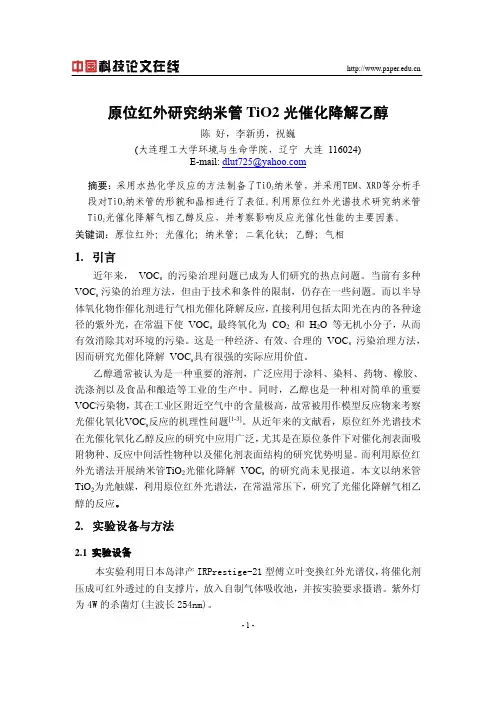
原位红外研究纳米管TiO2光催化降解乙醇陈 好,李新勇,祝巍(大连理工大学环境与生命学院,辽宁 大连 116024)E-mail: dlut725@纳米管,并采用TEM、XRD等分析手摘要:采用水热化学反应的方法制备了TiO2纳米管的形貌和晶相进行了表征。
利用原位红外光谱技术研究纳米管段对TiO2TiO光催化降解气相乙醇反应,并考察影响反应光催化性能的主要因素。
2关键词:原位红外;光催化;纳米管;二氧化钛;乙醇;气相1.引言近年来, VOC s的污染治理问题已成为人们研究的热点问题。
当前有多种VOC s 污染的治理方法,但由于技术和条件的限制,仍存在一些问题。
而以半导体氧化物作催化剂进行气相光催化降解反应,直接利用包括太阳光在内的各种途径的紫外光,在常温下使 VOC s最终氧化为 CO2和H2O 等无机小分子,从而有效消除其对环境的污染。
这是一种经济、有效、合理的 VOC s污染治理方法,因而研究光催化降解 VOC s具有很强的实际应用价值。
乙醇通常被认为是一种重要的溶剂,广泛应用于涂料、染料、药物、橡胶、洗涤剂以及食品和酿造等工业的生产中。
同时,乙醇也是一种相对简单的重要VOC污染物,其在工业区附近空气中的含量极高,故常被用作模型反应物来考察光催化氧化VOC s反应的机理性问题[1-3]。
从近年来的文献看,原位红外光谱技术在光催化氧化乙醇反应的研究中应用广泛,尤其是在原位条件下对催化剂表面吸附物种、反应中间活性物种以及催化剂表面结构的研究优势明显。
而利用原位红外光谱法开展纳米管TiO2光催化降解 VOC s的研究尚未见报道。
本文以纳米管TiO2为光触媒,利用原位红外光谱法,在常温常压下,研究了光催化降解气相乙醇的反应。
2.实验设备与方法2.1实验设备本实验利用日本岛津产IRPrestige-21型傅立叶变换红外光谱仪,将催化剂压成可红外透过的自支撑片,放入自制气体吸收池,并按实验要求摄谱。
紫外灯为4W的杀菌灯(主波长254nm)。
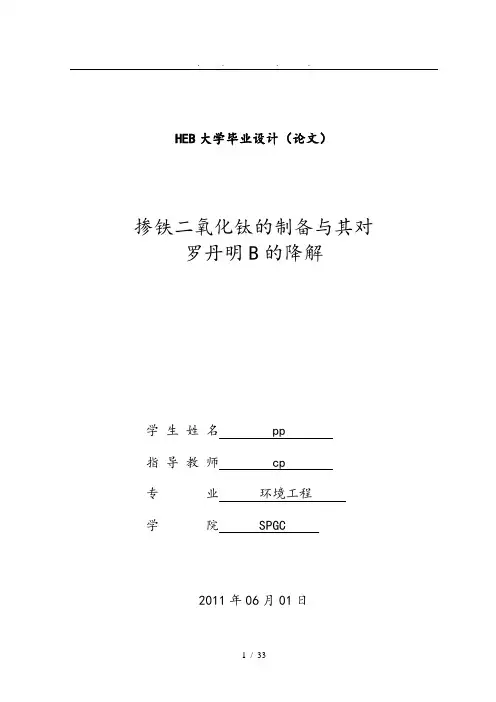
HEB大学毕业设计(论文)掺铁二氧化钛的制备与其对罗丹明B的降解学生姓名 pp指导教师 cp专业环境工程学院 SPGC2011年06月01日Graduation Project(Thesis)HarbinUniversity of CommerceThe preparation of iron-doped TiO2 andthe degradation of Rhodamine BStudentSupervisorSpecialty Environment EngineeringSchool2011-06-01毕业设计(论文)任务书毕业设计(论文)审阅评语毕业设计(论文)审阅评语毕业设计(论文)答辩评语摘要对改性TiO2的制备方法进行了研究。
以钛酸丁酯为前躯物,采用溶胶凝胶法制备纳米TiO2光催化材料。
对罗丹明B溶液进行光催化降解,寻求光催化降解罗丹明B 溶液条件。
实验结果表明:Fe-TiO2光催化材料的最优制备条件为前驱体配比(摩尔比)为n=Ti(OC4H9)4: C2H5OH: HNO3: H2O=1: 15:0.01:1,掺铁量W (Fe3+/TiO2)=0.6%,锻烧温度为450℃,锻烧时间为2h。
在此基础上,选择273nm波长的紫外灯对罗丹明B溶液催化进行催化降解实验,实验结果表明:紫外光下,pH=4最佳条件下Fe-TiO2处理罗丹明B溶液的脱色率达到90.2%。
研究表明,通过掺杂铁离子对二氧化钛进行的改性使反应的响应光谱向可见光拓展,并有效抑制电子—空穴对的复合,很大程度提高了光催化反应效率。
关键词:二氧化钛光催化掺铁制备AbstractIn this paper the preparation methods of modified TiO2was studied. Itis suggested that sol-gel method using Ti(OC4H9)4, is the best method forpreparation of TiO2photocatalytic materials. Rhodamine B solution to seek photocatalytic degradation,photocatalytic degradation Rhodamine B solution conditions.The optimal reaction condition was gotten after experiments and analysis:n=Ti(OC4H9)4:C2H5OH:HNO3:H2O=1:15:0.01:1(mol ratio),W(Fe3+/TiO2)=0.6%(molratio),calcinations at 450℃ for 2 hours.On this basis using ultraviolet germicidal lamp with wavelength of 273nm as Liaht-source, the contaminants removal effect in Rhodamine B.Experimental results show that: Under UV irradiation, pH=4 best conditions Fe-TiO2processing Rhodamine B determined.the decolored rate reached the solution as high as 90.2 %.The experiment results showed that photocatalytic activity was improved by sol-gel method by doping of Fe3+ and the photocatalytic efficiency were also raised obviously. The addition of appropriate amount of Fe3+is effective forimproving the photo-catalytic activities of TiO2by inhibiting the formation of recombination centers of photo-generated electron-hole pairs on thesurface of TiO2particles.Keywords:TiO2photocatalytic iron-doped preparing目录摘要IAbstractII1 绪论01.1 引言01.2 纳米TiO2光催化机理01.3 纳米TiO2的改性方法11.4 纳米TiO2的发展概况21.5 纳米TiO2光催化氧化技术的研究现状与应用前景31.6 本课题研究的目的和意义42 纯TiO2和掺铁TiO2的制备52.1 实验原理52.2 主要实验设备和药品52.3 二氧化钛和掺铁二氧化钛的制备过程62.4 正交实验确定制备TiO2各药品配比62.5 正交实验确定制备Fe-TiO2最佳条件82.6 Fe- TiO2光催化剂制备条件的影响102.6.1 锻烧温度的影响102.6.2 锻烧时间的影响112.6.3 掺铁量W(Fe3+/ TiO2)的影响122.7 小结133 光催化实验与其影响因素143.1 光催化机理143.2 光催化降解实验153.2.1 实验方法153.2.2 分析方法163.3 处理溶液pH的影响173.4 光催化时间影响183.5 小结19结论19参考文献21致221 绪论1.1引言二氧化钛,化学式为TiO2,俗称钛白粉,英文:Titanium (IV) oxide。
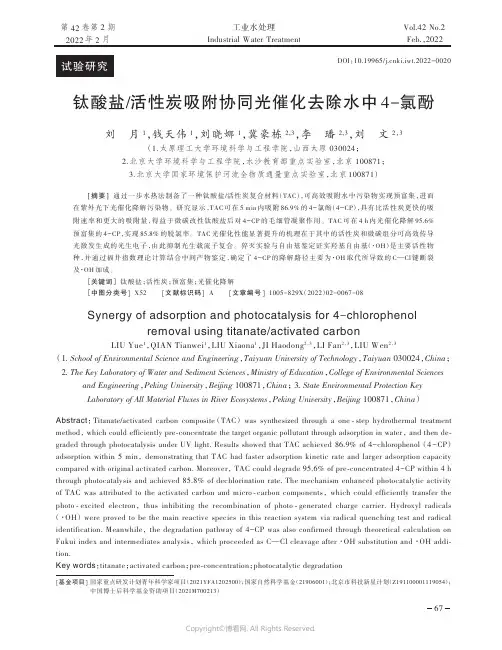
第42卷第2期2022年2月Vol.42No.2Feb.,2022工业水处理Industrial Water TreatmentDOI:10.19965/ki.iwt.2022-0020钛酸盐/活性炭吸附协同光催化去除水中4-氯酚刘月1,钱天伟1,刘晓娜1,冀豪栋2,3,李璠2,3,刘文2,3(1.太原理工大学环境科学与工程学院,山西太原030024;2.北京大学环境科学与工程学院,水沙教育部重点实验室,北京100871;3.北京大学国家环境保护河流全物质通量重点实验室,北京100871)[摘要]通过一步水热法制备了一种钛酸盐/活性炭复合材料(TAC),可高效吸附水中污染物实现预富集,进而在紫外光下光催化降解污染物。
研究显示,TAC可在5min内吸附86.9%的4-氯酚(4-CP),具有比活性炭更快的吸附速率和更大的吸附量,得益于微碳改性钛酸盐后对4-CP的毛细管凝聚作用。
TAC可在4h内光催化降解95.6%预富集的4-CP,实现85.8%的脱氯率。
TAC光催化性能显著提升的机理在于其中的活性炭和微碳组分可高效传导光激发生成的光生电子,由此抑制光生载流子复合。
猝灭实验与自由基鉴定证实羟基自由基(·OH)是主要活性物种,并通过福井指数理论计算结合中间产物鉴定,确定了4-CP的降解路径主要为·OH取代所导致的C—Cl键断裂及·OH加成。
[关键词]钛酸盐;活性炭;预富集;光催化降解[中图分类号]X52[文献标识码]A[文章编号]1005-829X(2022)02-0067-08Synergy of adsorption and photocatalysis for4−chlorophenolremoval using titanate/activated carbonLIU Yue1,QIAN Tianwei1,LIU Xiaona1,JI Haodong2,3,LI Fan2,3,LIU Wen2,3(1.School of Environmental Science and Engineering,Taiyuan University of Technology,Taiyuan030024,China;2.The Key Laboratory of Water and Sediment Sciences,Ministry of Education,College of Environmental Sciencesand Engineering,Peking University,Beijing100871,China;3.State Environmental Protection KeyLaboratory of All Material Fluxes in River Ecosystems,Peking University,Beijing100871,China)Abstract:Titanate/activated carbon composite(TAC)was synthesized through a one‑step hydrothermal treatment method,which could efficiently pre‑concentrate the target organic pollutant through adsorption in water,and then de‑graded through photocatalysis under UV light.Results showed that TAC achieved86.9%of4-chlorophenol(4−CP)adsorption within5min,demonstrating that TAC had faster adsorption kinetic rate and larger adsorption capacity compared with original activated carbon.Moreover,TAC could degrade95.6%of pre‑concentrated4-CP within4h through photocatalysis and achieved85.8%of dechlorination rate.The mechanism enhanced photocatalytic activity of TAC was attributed to the activated carbon and micro‑carbon components,which could efficiently transfer the photo‑excited electron,thus inhibiting the recombination of photo‑generated charge carrier.Hydroxyl radicals (·OH)were proved to be the main reactive species in this reaction system via radical quenching test and radical identification.Meanwhile,the degradation pathway of4-CP was also confirmed through theoretical calculation on Fukui index and intermediates analysis,which proceeded as C—Cl cleavage after·OH substitution and·OH addi‑tion.Key words:titanate;activated carbon;pre‑concentration;photocatalytic degradation[基金项目]国家重点研发计划青年科学家项目(2021YFA1202500);国家自然科学基金(21906001);北京市科技新星计划(Z191100001119054);中国博士后科学基金资助项目(2021M700213)试验研究工业水处理2022-02,42(2)氯酚类物质(CPs)是工业废水中最常见的持久性有机污染物之一,主要来源包括工业制革与防腐剂、杀虫剂、防污剂的合成等。
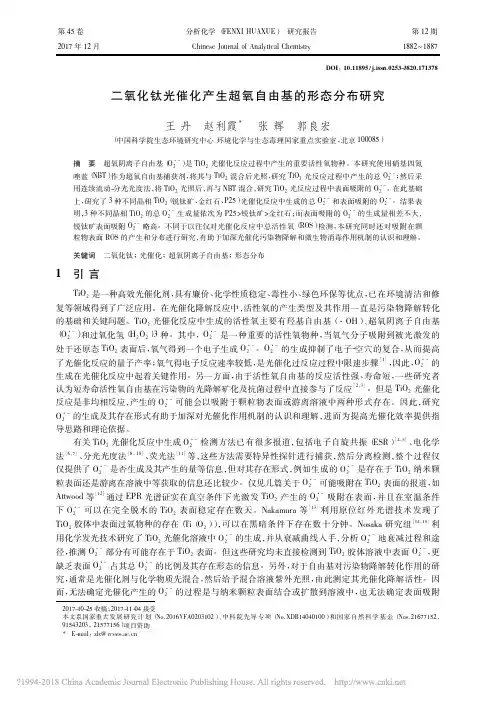
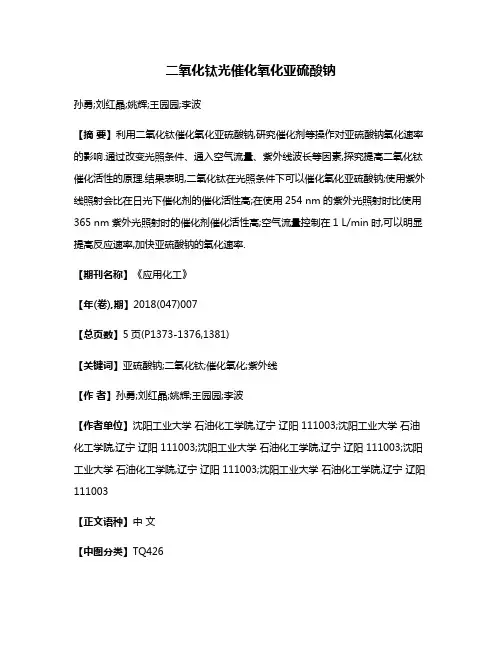
二氧化钛光催化氧化亚硫酸钠孙勇;刘红晶;姚辉;王园园;李波【摘要】利用二氧化钛催化氧化亚硫酸钠,研究催化剂等操作对亚硫酸钠氧化速率的影响.通过改变光照条件、通入空气流量、紫外线波长等因素,探究提高二氧化钛催化活性的原理.结果表明,二氧化钛在光照条件下可以催化氧化亚硫酸钠;使用紫外线照射会比在日光下催化剂的催化活性高;在使用254 nm的紫外光照射时比使用365 nm紫外光照射时的催化剂催化活性高;空气流量控制在1 L/min时,可以明显提高反应速率,加快亚硫酸钠的氧化速率.【期刊名称】《应用化工》【年(卷),期】2018(047)007【总页数】5页(P1373-1376,1381)【关键词】亚硫酸钠;二氧化钛;催化氧化;紫外线【作者】孙勇;刘红晶;姚辉;王园园;李波【作者单位】沈阳工业大学石油化工学院,辽宁辽阳 111003;沈阳工业大学石油化工学院,辽宁辽阳 111003;沈阳工业大学石油化工学院,辽宁辽阳 111003;沈阳工业大学石油化工学院,辽宁辽阳 111003;沈阳工业大学石油化工学院,辽宁辽阳111003【正文语种】中文【中图分类】TQ426为了减少SO2的排放,创造了各种不同的脱硫工艺[1-2]。
但脱硫工艺过程中会有亚硫酸盐的生成,若氧化不充分则会引起严重的结垢和堵塞[3],并会分解释放出SO2。
如今我国大多数工厂在处理亚硫酸钠时,只是加热搅拌使其自然氧化,这个过程耗时长效率低,因此如何提高亚硫酸盐的氧化速度成为了研究重点。
自1972年Fujishima等[4]发现TiO2具有光催化性能以来,纳米量级TiO2的光催化特性被逐步发现,可用于处理污水废气、杀菌等[5-7]。
因TiO2不易回收等问题,可以用硅藻土等负载TiO2[8],以实现纳米TiO2回收再利用。
本文使用纳米TiO2催化亚硫酸钠氧化反应,研究TiO2在亚硫酸盐氧化过程中的光催化效果,探究了紫外线、空气流量、亚硫酸盐浓度、催化剂浓度等变量对TiO2光催化过程的影响。
纳米二氧化钛光催化降解染料废水动力学研究张建斌;田海锋;查飞;左国防;雷新有;唐惠安【摘要】以纳米二氧化钛为光催化剂,研究了光催化降解染料废水溶液的动力学规律及溶液的pH 值、TiO2投加量和染料起始浓度对光催化降解活染料废水动力学的影响。
结果表明,该反应符合Langmuir-Hinshelwood(L-H)动力学模型,且光催化过程符合一级反应动力学方程,一级反应动力学常数( K')随溶液 pH值及染料起始浓度的降低而增大;TiO2的最佳投加量为2.0 g/L,低于或超过该值都会导致降解速率的下降。
%The dynamics of photocatalytic degradationof dyeing waste water has been investigated by using nano-TiO2 as photocatalyst. Furthermore,the effects of operation parameters such as initial dye concentra-tion,catalyst loading,and solution of the pH on the dynamics of photocatalytic degradation were dis-cussed. The results showed that the reaction accords with Langmuir-Hinshelwood( L-H)model and the reaction is a first-order reaction and the reaction kinetics constant( K')increase with the decrease of pH value and the initial concentration of dye. Meanwhile,the K' value would decrease when the addition of TiO2 is beyond or below the optimum amounts of TiO2 2. 0 g/L.【期刊名称】《应用化工》【年(卷),期】2014(000)008【总页数】4页(P1369-1372)【关键词】二氧化钛;光催化降解;染料废水;动力学【作者】张建斌;田海锋;查飞;左国防;雷新有;唐惠安【作者单位】天水师范学院生命科学与化学学院,甘肃天水 741001; 天水师范学院新型分子材料设计与功能重点实验室,甘肃天水 741001;西北师范大学化学化工学院,甘肃兰州 730070;西北师范大学化学化工学院,甘肃兰州 730070;天水师范学院生命科学与化学学院,甘肃天水 741001; 天水师范学院新型分子材料设计与功能重点实验室,甘肃天水 741001;天水师范学院生命科学与化学学院,甘肃天水 741001; 天水师范学院新型分子材料设计与功能重点实验室,甘肃天水 741001;天水师范学院生命科学与化学学院,甘肃天水 741001; 天水师范学院新型分子材料设计与功能重点实验室,甘肃天水 741001【正文语种】中文【中图分类】TQ426.8染料生产企业由于废水浓度高、污染物复杂、排污量大等因素而受到广泛关注。
纳米 !"#$光催化剂的制备方法方世杰徐明霞(天津大学材料学院,天津%&&&’$)摘要介绍了二氧化钛粉体和薄膜的制备技术,比较了各种方法的优缺点。
其中对液相法作了较为全面的介绍。
关键词纳米 !"#$催化剂气相法液相法国家自然科学基金资助项目((&&’$&)*);天津市自然科学基金资助(&)%+&%,)))作者简介:方世杰()-’+ . ),男,硕士/)引言纳米 !"#$光催化剂是一种新型的并且正在迅速发展的高效光谱催化剂,成为近年来环保技术中的一个研究热点。
一种良好的催化剂必须具有很大的催化表面,并且有很高的光子利用率。
当 !"#$达到纳米时,会表现出更优良的光催化降解性能。
关于纳米 !"#$的制备技术已有很多论述,本文试图对近年来纳米二氧化钛的制备技术作一个综述。
$!"#$纳米粉体的制备目前制备 !"#$纳米微粒的方法有很多种,根据对所要求制备微粒的性状、结构、尺寸、晶型、用途,采用不同的制备方法。
按照原料的不同大致分为 $ 类:气相法和液相法。
但无论采用何种方法,制备纳米粒子都有如下要求[)]:表面光洁;粒子的形状及粒径、粒度分布可控,粒子不易团聚;易于收集;热稳定性优良;产率高。
!/"气相法气相法是直接利用气体或通过各种手段将物质变为气体,使之在气态下发生物理变化或化学变化,最后在冷却过程中凝聚长大形成纳米粒子的方法。
气相法的特点是粉体纯度高、颗粒尺寸小、颗粒团聚少、组分更易控制。
$/)/)化学气相沉积法(012)[$]化学气相法制备纳米 !"#$的初级过程包括:气相化学反应、表面反应、均相成核、非均相成核、凝结聚集或融合。
气相反应所需的母体有 $ 类:!"03*和钛醇盐。
化学反应可分为 * 类。
())!"03*与 #$氧化,化学反应方程式为:!"03* (4)5 #$ (4)6 !"#$5 $03$7 !"#$ (4)6(!"#$)7 (8)($)钛醇盐直接热裂法[%],化学反应方程式为:!" (#9)*6 !"#$5 *07:$75 $:$#(%)钛醇盐气相水解法(气溶胶法),化学反应方程式为:!" (#9)*5 $:$# 6 !"#$5 *9#:(*)气相氢火焰法,化学反应方程式为:!"03*5 $:$5 #$6 !"#$5 *:03$/$/$激光 012 法激光 012 法也是一种很好的制备方法。
Advances in Environmental Research 8(2004)329–3351093-0191/04/$-see front matter ᮊ2002Elsevier Science Ltd.All rights reserved.PII:S1093-0191Ž02.00106-5Photocatalytic oxidation of acetonitrile in aqueous suspension oftitanium dioxide irradiated by sunlightV .Augugliaro ,A.Bianco Prevot ,J.Caceres Vazquez ,E.Garcıa-Lopez ,A.Irico ,a b ca b ´´´´V .Loddo ,S.Malato Rodrıguez ,G.Marcı,L.Palmisano *,E.Pramauro a ca a ,b ´`Dipartimento di Ingegneria Chimica dei Processi e dei Materiali,Universitadi Palermo,viale delle Scienze,90128Palermo,a`ItalyDipartimento di Chimica Analitica,Universitadi Torino,via P .Giuria,5,10125Torino,Italy b`Plataforma Solar de Almerıa,Crta.Senes s y n,04200Tabernas,Almeria,Spain c´´Received 8August 2002;received in revised form 17August 2002;accepted 20August 2002AbstractThe photocatalytic oxidation of acetonitrile (CH CN )was carried out in aqueous suspensions of polycrystalline3TiO P25Degussa irradiated by sunlight.A plug flow photoreactor in a total recycle loop was used for carrying out 2reactivity experiments in which the concentrations of acetonitrile,of its intermediate oxidation products and of not-purgeable organic carbon (NPOC )were monitored.The influence of the presence of strong oxidant species (H O ,22S O ,ClO )on the process rate was studied.The dependence of acetonitrile photo-oxidation rate on the substrate 2y y28concentration and on the catalyst amount was also investigated.The photodegradation rate of substrate and NPOC followed first order kinetics with respect to acetonitrile and NPOC concentrations,respectively.The presence ofS O and solar irradiation determined the occurrence of homogeneous degradation of acetonitrile and NPOC.In the 2y28presence of irradiated catalyst,a significant synergetic effect was observed for NPOC degradation while for the acetonitrile oxidation this effect was not evident.H O did not affect the process while ClO affected negatively the y 22acetonitrile oxidation rate and it inhibited the NPOC degradation.ᮊ2002Elsevier Science Ltd.All rights reserved.Keywords:Photocatalytic oxidation;Acetonitrile;Sunlight;Titanium dioxide1.IntroductionHeterogeneous photocatalysis is a growing field of basic and applied research especially for the case of oxidation processes of organic pollutants carried out by using aqueous oxygenated suspensions of polycrystal-line semiconductors (Schiavello,1988;Pelizzetti and Serpone,1989;Ollis and Al-Ekabi,1993).In order to improve the performance of a photocatalytic process,two main routes have been tested.The first one consists in modifying the photocatalyst by doping it with sub-*Corresponding author.Fax:q 39-91-656-7280.E-mail address:palmisan@dicpm.unipa.it (L.Palmisano ).stances that (i )enhance the efficiency of the charge separation step or (ii )induce a shift of the absorption edge towards the visible region.The second route consists in modifying the reaction ambient by adding substances such as hydrogen peroxide (Augugliaro etal.,1990),ozone (Sanchez et al.,1998;Piera et al.,´2000),peroxydisulphate ions (Augugliaro et al.,1999b ),or Fenton reagents (Piera et al.,2000;Sanchez et al.,´1997)that eventually increase the overall oxidation rate.Acetonitrile is an extremely stable and toxic molecule.It is used as a solvent in photocatalytic oxidation reactions (Abdel Wahab and Gaber,1998;Somasundar-am and Srinivasan,1998;Fujiwara et al.,1999;O’Shea330V .Augugliaro et al./Advances in Environmental Research 8(2004)329–335Fig. 1.Scheme of the photoreacting system:(a )sampling valve;(b )thermocouple;(c )not-reacting tank;(d )pump;(PFP )plug flow photoreactor.et al.,1999)and it is often found in various civil and industrial wastewaters due to its use as eluent for HPLC analyses.The photo-oxidation of acetonitrile adsorbed on TiO ,both in liquid and in gas phase,by using O as 22oxidant,was recently investigated (Lichtin and Avudai-thai,1996).The production of cyanogen (CN )as 2intermediate species has been reported thus indicating the formation of CN radicals which can dimerize.•Moreover,it was demonstrated that acetonitrile is much more reactive in gas phase than in liquid phase.Aceton-itrile adsorption and photo-oxidation in gas phase has been also studied by means of infrared spectroscopy (Zhuang et al.,1999).The final oxidation products inthe presence of O were CO ,H O and CO (onto 2y2223surface ),but also isocyanate was found as a partially oxidised species.The presence of isocyanate and y or cyanate is a clear clue of the formation of free cyanide.Indeed,previous studies showed that the main oxidation products of free and complex cyanide were cyanate,nitrite,nitrate and carbonate species (Augugliaro et al.,1997,1999a,b ).In the present investigation the photo-catalytic oxidation of acetonitrile was carried out in aqueous suspensions of titanium dioxide irradiated by sunlight.The concentrations of substrate and not-pur-geable organic carbon (NPOC )were monitored.The influence of the substrate concentration and catalyst amount on the photoreaction rate was investigated.Moreover,the determination of organic and inorganic species,formed as intermediate products in the course of acetonitrile photo-oxidation,was also carried out.On the basis of the finding that sometimes the presence of strong oxidant species enhances the photo-oxidation rate of organic compounds (Augugliaro et al.,1990;Bianco Prevot et al.,2001),some photoreactivity tests were carried out by adding hydrogen peroxide or peroxydisulphate or hypochlorite ions to the reacting system.2.ExperimentalThe photoreactivity experiments were carried out by using not concentrating compound parabolic collectors(CPC ),installed at the ‘Plataforma Solar of Almerıa’´(PSA,Spain ).Two identical reacting systems were contemporarily used in order to perform photoreactivity runs at the same irradiation conditions and therefore to check the reproducibility of the results.The photoreactor configuration,reported in Fig.1,is a common one in heterogeneous photocatalysis field:a plug flow reactor in a total recycle loop with a not-reacting stirred tank whose function is that of providing aeration and samples for analyses.Each photoreactor consisted of three CPC modules in series (total irradiated surface:3.08m )2placed on fixed supports inclined 378(latitude of the PSA )with respect to the horizontal plane and facingSouth,in order to maximise the daily absorption of solar radiation.The collectors are not concentrating ones,i.e.the ratio between the surface where the solar radiation impinges and that of the reactor is approxi-mately equal to 1.1.The plug flow photoreactor (PFP )consisted of UV–transparent glass tubes (i.d.29.2mm ).All the tubes were connected in series and the aqueous suspension was continuously fed to the PFP from the not-reacting tank by means of a centrifugal pump.The suspension flow rate,maintained constant for all the runs,was 0.334dm s .The Reynolds number value was equal 3y 1to approximately 1.7=10indicating a turbulent regime 4of the flow inside the tubes.The total volume,V ,of t suspension charged in the whole system was 39dm ,3whereas the irradiated volume,V ,i.e.the volume of i suspension contained in the glass tubes,was 22dm .3The catalyst used for the photoreactivity experiments was polycrystalline TiO (P25,Degussa,approximately 280%anatase and 20%rutile,BET surface area approx-imately 50m g ).2y 1The catalyst amounts were in the 0.2–0.4g dm y 3range.The acetonitrile initial concentrations were in the 0.122–1.220mM range and the initial pH was adjusted to approximately 11with NaOH.The experimental runs were carried out by using the following procedure:firstly,the aqueous suspension containing the organic compound and the TiO powder was circulated in the 2reacting system by maintaining the collectors covered.After 30min of this operation the cover was removed and the reactivity run started.Samples of the suspension were withdrawn at the starting of irradiation and at fixed intervals of time.It must be reminded that the samples were withdrawn from the not-reacting tank so that they are representative of the conditions at the inlet331V .Augugliaro et al./Advances in Environmental Research 8(2004)329–335Fig.2.CH CN concentrations versus the cumulative photon energy for runs carried out at different initial CH CN concentrations.33In the inset the corresponding values of NPOC concentrations are reported.Catalyst amount 0.2g l ;initial pH 11.y 1of the PFP .Some runs were carried out by adding hydrogen peroxide or sodium peroxydisulphate or sodi-um hypochlorite to the reacting suspension.H O was 22added each hour in order to maintain its concentration in aqueous solution equal to the stoichiometric amount needed for the complete oxidation of the initial substrate(CH CN:H O molar ratio:1:8).The CH CN:S O 2y322328molar ratio was 1:8,corresponding to the S O stoi-2y28chiometric amount needed for obtaining the complete oxidation of initial content of carbon and nitrogen atoms.When S O was added,pH was monitored during the 2y28run and it was re-adjusted to approximately 11several times with NaOH.A few runs were carried out by adding ClO ions with a CH CN:ClO molar ratio y y 3equal to 1:8.The quantitative determination of CH CN was rou-3tinely performed by using a gas chromatograph (Hew-lett-Packard,GC 6890system )equipped with a 5%phenyl methyl siloxane 30m =320m m =0.25m m column (Hewlett-Packard HP-5)and a FID detector.Chromatographic grade Helium was used as carrier.The sample was placed in a vial and the compounds present in the vapour phase were extracted (extraction time,5min )by using a 75m m Carboxen-PDMS SPME (Solid Phase Micro Extraction )fiber assembly (Supel-co )with a fiber holder for manual sampling.Then the holder was placed in the split y splitless injector,main-tained at a temperature of 2508C for 2min before starting the analysis.The temperature of the oven was held at 408C for the first 3min,then it was increased up to 2508C at a rate of 608C min .y 1All the reagents were analytical grade (Fluka ).The quantitative determination of ionic species was carried out by using an ionic chromatograph system (Dionex DX 120)equipped with an Ion Pac AS144mm column (250mm long,Dionex ).Aqueous solutions ofNaHCO (1mM )and Na CO (3.5mM )were used as 323eluants at a flow rate of 1.67=10cm s .The y 23y 1samples were filtered before analyses by using Millipore MVLP filters,0.45m m.A 5050A Shimadzu total organic carbon analyser was used in order to determine the NPOC content of the samples.In order to compare experimental runs carried out on different days with different solar irradiances,the values of irradiance were monitored and recorded during the runs by using a sensor for global UV-light measurements (Eppley-TUVR )installed in the same position of the CPCs.3.Results and discussionPreliminary photoreactivity experiments were carried out with catalyst amount in the 0.2–0.4g dm range.y 3The results did not differ appreciably so that all the runs were performed by using a constant catalyst amount of 0.2g dm .In order to compare photoreactivity y 3results obtained under different conditions of irradiation,the values of acetonitrile concentration were reported vs.the cumulative photon energy,E ,incident on the reactor.This quantity is given by:tE sI (t )d t (1)|in which I (t )is the instantaneous photon flow w einstein s x and t the irradiation time.The values of y 1I (t )were calculated from the recorded values of irradi-ance,UVG (t ),by using the following relationship:I (t )s UVG (t )S(2)332V .Augugliaro et al./Advances in Environmental Research 8(2004)329–335Fig.3.Concentration of acetonitrile (ࡗ),cyanate (j ),nitrate (m ),and nitrogen balance (d )vs.the cumulative photonic energy.Catalyst amount 0.2g l ,initial pH 11.y1Fig.4.Concentration of acetonitrile vs.the cumulative pho-tonic energy,E ,in the absence of chemical oxidant species(ࡗ)and in the presence of H O (j )or S O (m )or2y2228ClO (d ).In the inset the corresponding values of NPOC yconcentrations are reported.Catalyst amount 0.2g l ,initial y 1pH11.Fig.5.Acetonitrile concentration vs.the cumulative photonic energy,E ,for runs carried out in the absence of chemical oxi-dant species (m ),in the presence of S O (j )and in the 2y28presence of S O in homogeneous phase (ࡗ).In the inset 2y28the corresponding values of NPOC concentrations are reported.Catalyst amount 0.2g l ,initial pH 11.y 1in which S is the total irradiated surface and UVG is the irradiance expressed as W m .The UVG dimen-y 2sions were transformed in w einstein s m x by using y 1y 2the Planck’s equation (E s hc y l ).By considering that the TiO (anatase )band gap energy corresponds to a 2wavelength of 387nm,the conversion factor from w W m x to w einstein s m x has the value of y 2y 1y 23.23=10.y 6It is worth noting that 6einstein correspond approx-imately to 5h of sunlight irradiation (10.00–15.30h ).Fig.2shows the substrate and NPOC (in the inset )concentration values (expressed as mmoles l of sub-y 1strate or organic carbon )respectively,measured at the inlet of the photoreactor,vs.the cumulative photon energy,E ,for selected experiments.The runs were carried out at different initial CH CN concentrations 3and an initial pH of 11.Degraded acetonitrile was oxidised to carbonate and nitrate and the main inorganic intermediate detected was cyanate,while only traces of cyanide and nitrite were found.The main organic intermediate detected was HCOO ,probably derived y from the presence of methanol (formed by oxidation of the methyl group of acetonitrile )which can be oxidised to methanol and then to methanoic acid that in alkaline medium is found as methanoate.Fig.3reports,for a typical run carried out with a catalyst amount of 0.2g l and an initial pH of 11,y 1the experimental values of acetonitrile,cyanate and nitrate concentrations versus E .In Fig.3the nitrogen balance is also reported.It can be observed that the nitrogen mass balance is quite well satisfied during the course of the run thus indicating that no significant formation of additional nitrogen-containing species occurred.Acetonitrile degradation was quite low,prob-ably due to the competition of OCN with acetonitrile y on the same active sites.Moreover,it is reported in the pertinent literature (Augugliaro et al.,1997,1999a,b )that OCN is slowly photo-oxidised.y Fig.4shows the results obtained in the presence of oxidant species such as hydrogen peroxide or peroxy-disulphate or hypochlorite;the results obtained without oxidant species are also reported.For the run carriedout in the presence of S O the pH value was main-2y28tained equal to 11during the course of the experiment.From the observation of this figure it can be noticedthat the reaction rate increases by adding S O ,where-2y28as the presence of H O does not affect the photoreac-22tivity and that of ClO decreases the activity.y Fig.5reports the reactivity data obtained:(i )in the presence of catalyst;(ii )with homogeneous solutioncontaining S O ;and (iii )in the presence of catalyst2y28and of dissolved S O .Preliminary runs,carried out 2y28in the dark with homogeneous solution containingS O or H O or ClO ,showed a not measurable 2yy 2822reactivity.333V .Augugliaro et al./Advances in Environmental Research 8(2004)329–335Table 1Values of true kinetic constants obtained for runs with different initial acetonitrile concentrations and with different oxidant speciesk 9(einstein )10y 12obs TiO 2TiO q H O 222TiO q S O 2y228TiO q ClO y 2S O 2y28homogeneousC 0,ACN CH CN 3NPOC CH CN 3NPOC CH CN 3NPOC CH CN3NPOCCH CN 3NPOC (mM )0.12 4.98.2––––––0.24 4.7 6.6––16249.5 2.50.49 4.77.3––––––1.24.86.74.88.315203.80.0––It may be observed that the homogeneous photode-gradation of acetonitrile with S O is comparable to 2y28the heterogeneous photocatalytic one.In the presenceof S O and catalyst the decrease of acetonitrile 2y28concentration seems due to the cumulative effects of the heterogeneous photo-oxidation reaction and the homogeneous photoreaction.A photocatalytic run was carried out with peroxydi-sulphate but without re-adjusting the pH to 11during the occurrence of the reaction.It was observed that the pH decreased to approximately 3,due to the reductionof S O to sulphuric acid,and the disappearance rates 2y28of CH CN and NPOC increased considerably.The 3positive effect of acidic pH on the acetonitrile degra-dation rate is difficult to clarify.A tentative explanation could be the formation and the release in the gas phase of HCN from CN at acidic pH before the oxidation y of CN to OCN .Then,the competition between y y OCN and acetonitrile on the same active sites would y be less important,while likely explanations for the improvement of NPOC disappearance rate could be the transformation of CN ,formed during the acetonitrile y photo-oxidation,in volatile hydrogen cyanide and y or the transformation of CNO produced by the cyanide y photocatalytic oxidation,in cyanic acid,HCNO,which in solution decomposes to form ammonia,carbon diox-ide and water (Cotton and Wilkinson,1972).After testing different kinetic models to the data of CH CN (ACN )and NPOC concentrations vs.E ,it was 3found that the first order kinetics,expressed by the following equations dC ACNys k C obs ,ACN ACNdE dC NPOC y s k C (3)obs ,NPOC NPOCdE best fitted the experimental data.The integration of Eq.(3)with the limiting conditions that at the start of the reaction (E s 0)acetonitrile and NPOC concentrations are equal to the initial ones (C s C ;C s ACN 0,ACN NPOC C )gives:0,NPOC y k E (obs,ACN )C s C e ACN 0,ACN y k E (obs,NPOC )C s C e (4)NPOC 0,NPOC By applying a least-square best fitting procedure to the experimental data,the values of k and obs,ACN k were determined for all the runs.The photo-obs,NPOC reacting system used in this work is a total recycling one composed by a PFP and a mixing tank.The reaction of substrate oxidation only occurs inside the irradiated PFP while the not-reacting tank determines that the substrate concentration at the PFP inlet is different from the outlet one.The system is not at steady state so that the inlet and outlet PFP concentrations are changing with irradiation time.The dynamics of this system have been deeply discussed (Wolfrum and Turchi,1992;Augugliaro et al.,1999b ).In order to obtain the true kinetic constants,the observed reactivity data of CH CN 3and NPOC concentrations must be normalised by mul-tiplying them by the ratio of the total volume to the irradiated volume,V y V .In the present case,being the t i kinetics of first order,the true kinetic constants are obtained from the observed ones by means of the following simple relationships:V V t t k 9s k k 9s k (5)obs ,ACN obs ,ACNobs ,NPOC obs ,NPOCV V iiThe calculated values of true kinetic constants,k 9,both for CH CN and NPOC degradation are reported in 3Table 1.For the photocatalytic runs carried out without the addition of oxidant compounds Table 1shows that the k 9values are independent of the initial concentra-obs,ACN tion of CH CN.Indeed by using the Langmuir–Hin-3shelwood model,the kinetic equation for a first order reaction occurring on the catalyst surface is:dC k K C ACN ACN ACN ACNys (6)dE 1q K C q K CACNACNii8i334V .Augugliaro et al./Advances in Environmental Research 8(2004)329–335in which k indicates the first order rate constant,K the equilibrium adsorption constant and C the concentration in the aqueous phase.The ‘ACN’and ‘i ’subscripts refer to CH CN and its intermediate degradation prod-3ucts,respectively.If the organic species are scarcely adsorbed on the catalytic surface,the K C and ACN ACN K C terms are negligible so that equations can be i i rewritten as:dC ACNys k K C (7)ACN ACN ACNdEBy comparing Eq.(7)with Eq.(3)(for ACN )it may be noted that the k K term corresponds to ACN ACN k .The addition of peroxydisulphate ion increases obs,ACN the values of the k and k but it does not obs,ACN obs,NPOC modify the independence of the kinetic constant of the substrate concentrations.In the contemporary presenceof catalyst and S O the value of k is quite 2y28obs,ACN similar to the sum of k values obtained by only obs,ACN heterogeneous photocatalysis and homogeneous photo-reaction.This feature suggests that these two processes are independent,parallel ways for acetonitrile degrada-tion.On the contrary the k value obtained withobs,NPOC catalyst and S O is greater than the sum of those 2y28obtained with photocatalysis and homogeneous photo-reaction.It may be therefore concluded that S O ions 2y28do not participate in the photocatalytic degradation of acetonitrile:however,they positively affect the degra-dation rate of the intermediate degradation products of acetonitrile.As far as the H O and ClO roles are concerned,y 22the data of Table 1indicate that hydrogen peroxide does not affect the photodegradation process while hypochlo-rite ion negatively affects the acetonitrile oxidation rate and in addition it seems to inhibit the NPOC degradation.4.ConclusionsThe photocatalytic oxidation of acetonitrile was car-ried out in the presence of polycrystalline TiO irradi-2ated by sunlight.The substrate and NPOC photo-oxidation rates follow first order kinetics with a low fractional sites coverage both for the substrate and its organic intermediates under the used experimental conditions.The presence of H O in the reacting medi-22um did not influence the acetonitrile photodegradation rate,while the addition of peroxydisulphate had a beneficial effect.The presence of ClO is detrimental y for both acetonitrile and NPOC photodegradation.Thefinal oxidation products were CO and NO ,while 2yy 33the main intermediate products were HCOO and y CNO .y AcknowledgmentsThe authors like to thank the ‘Improving Human Potential’programme of EU-DGXII for financial sup-port and availability of the facilities located at thePlataforma Solar of Almerıa (Spain ).´ReferencesAbdel Wahab,A.,Gaber,A.,1998.TiO photocatalytic oxi-2dation of selected heterocyclic sulfur compounds.J.Photo-chem.Photobiol.A:Chem.114,213–218.Augugliaro,V .,Davı,E.,Palmisano,L.,Schiavello,M.,Scla-`fani, A.,1990.Influence of hydrogen peroxide on the kinetics of phenol photodegradation in aqueous titanium dioxide dispersion.Appl.Catal.65,101–116.Augugliaro,V .,Loddo,V .,Lopez Munoz,M.J.,Marcı,G.,´˜`Palmisano,L.,1997.Photocatalytic oxidation of cyanides in aqueous titanium dioxide suspensions.J.Catal.166,272–283.Augugliaro,V .,Garcıa Lopez, E.,Loddo,V .,Marcı,G.,´´`Palmisano,L.,1999a.Degradation kinetics of iron (III )cyanocomplexes in irradiated systems.Adv.Environ.Res.3,179–188.Augugliaro,V .,Blanco Galvez,J.,Caceres Vazquez,J.,et al.,´´´1999b.Photocatalytic oxidation of cyanide in aqueous TiO suspensions irradiated by sunlight in mild and strong 2oxidant conditions.Catalysis Today 54,245–253.Bianco Prevot,A.,Baiocchi,C.,Brussino,M.C.,et al.,2001.Photocatalytic degradation of acid blue 80in aqueous solutions containing TiO suspensions.Environ.Sci.Tech-2nol.35,971–976.Cotton,F .A.,Wilkinson,G.,1972.Advanced in Organic Chemistry.3rd.Wiley,New Y ork.Fujiwara,H.,Kitamura,T.,Wada,Y.,Yanagida,S.,Kamat,P .V .,1999.Onium salt effects on p -terphenyl-sensitized photoreduction of water to hydrogen.J.Phys.Chem.A 103,4874–4878.Lichtin,N.N.,Avudaithai,M.,1996.TiO -photocatalyzed oxi-2dative degradation of CH CN,CH OH,C HCl ,and 3323CH Cl supplied as vapors and in aqueous solution under 22similar conditions.Environ.Sci.Technol.30,2014–2020.Ollis,D.F .,Al-Ekabi,H.(Eds.),1993.Photocatalytic Purifi-cation and Treatment of Water and Air.Elsevier,Amsterdam,.O’Shea,S.,Jannach,H.,Garcia,I.,1999.The reactions of substituted acylic 1,3-butadienes on photoexcited TiO in 2acetonitrile.J.Photochem.Photobiol.A:Chem.122,127–131.Pelizzetti,E.,Serpone,N.(Eds.),1989.Photocatalysis:Fun-damental and Applications.Wiley,New Y ork.Piera,E.,Calpe,J.C.,Brillas,E.,Domenech,X.,Peral,J.,`2000.2,4-Dichlorophenoxyacetic acid degradation by cata-lyzed ozonization:TiO y UV A y O and Fe (II )y UV A y O sys-233tems.Appl.Catal.B:Environ.27,169–177.Sanchez,L.,Peral,J.,Domenech,X.,1997.Photocatalyzed ´`destruction of aniline in UV-Illuminated aqueous TiO sus-2pensions.Electrochim.Acta 42,1877–1882.335 V.Augugliaro et al./Advances in Environmental Research8(2004)329–335Sanchez,L.,Peral,J.,Domenech,X.,1998.Aniline degrada-´`tion by combining photocatalysis and ozonization.Appl.Catal.B:Environ.19,59–65.Schiavello,M.(Ed.),1988.Photocatalysis and Environment, Trends and Applications.Kluwer,Dordrecht. Somasundaram,N.,Srinivasan, C.,1998.Oxygenation of aldimines and deoxygenation of nitrones on irradiated TiO.2 Tetrahedron Lett.21,3547–3550.Zhuang,J.,Rusu, C.N.,Yates,J.T.,1999.Adsorption andphotooxidation of CH CN on TiO.J.Phys.Chem.103,326957–6967.Wolfrum, E.J.,Turchi, C.S.,ments on‘reactor dynamics in the evaluation of photocatalytic oxidation kinetics’.J.Catal.136,626–628.Vincenzo Augugliaro is full professor of Transport Phenomena at Palermo University,Faculty of Engineer-ing.He is expert of photoreactors and kinetics of chemical processes and he is involved in several national and international projects on photocatalysis.He is author of many scientific publications in international and national journals and books.Alessandra Bianco Prevot Ph.D.of research,is researcher at the Department of Analytical Chemistry of the University of Torino.Her main activity concerns the analytical and environmental problem of the removal of pollutants from water and solids,with particular attention to the use of surfactants as solvent system and to the photocatalytic degradation of organic pollutants. Julia Caceres Vazquez is finishing her Ph.D.of ´´research at the Plataforma Solar de Almerıa,institution´belonging to the Spanish Ministry of Science and Technology.She has been involved in5National and European Projects related with the development of Solar Technologies applied to wastewater treatment.She is author of some publications in international journals. Elisa Garcıa-Lopez obtained the degree in Chemistry ´´in1993at the Universidad Autonoma of Madrid.Cur-rently she is researcher of Chemistry at Palermo Uni-versity,Faculty of Engineering.Her research work is in the field of photocatalysis both in gas-phase and liquid-phase regimens and she is author of some publications in international journals.Alessandra Irico Ph.D.of research,is technician at the Department of Analytical Chemistry of the Univer-sity of Torino.Her main activity concerns the develop-ment of analytical procedures for the analysis of organic molecules,mainly using the mass spectrometry technique.Vittorio Loddo is Ph.D.of research in Chemical Engineering.Currently he is researcher of Principle of Chemical Engineering at Palermo University,Faculty of Engineering.His research work is in the field of reactor modelling for photocatalytic reactions and he is author of some publications in international and national jour-nals and books.Sixto Malato Rodrıguez is Ph.D.of research in Chem-´ical Engineering.At present he has a permanent position as Senior Researcher of the Spanish Ministry of Science and Technology.He has been involved in9European Union,9National R&D Projects and5R&D Contracts related with the development of Solar Technologies applied to wastewater treatment.He is author of many scientific publications in international and national jour-nals and books.Giuseppe Marcıis Ph.D.of research in Chemical`Technology.Currently he is researcher of Chemistry at Palermo University,Faculty of Engineering.His research work is in the field of photocatalytic reactions involving organic and inorganic molecules in heteroge-neous systems.He is author of some scientific publications in international and national journals. Leonardo Palmisano is full professor of Chemistry at Palermo University,Faculty of Engineering.He is well experienced in co-ordination chemistry and expert in photocatalysis and he is involved in several national and international research projects.He is author of many scientific publications in international and national jour-nals and books.Edmondo Pramauro is full professor of Analytical Chemistry at the University of Torino.His main research fields are:the study of surfactant applications in analyt-ical chemistry and separation science,with particular attention devoted to micelle-based extraction and ultra-filtration procedures,and the investigation of pollutants degradation in treatments based on photocatalysis over semiconductors dispersions.。